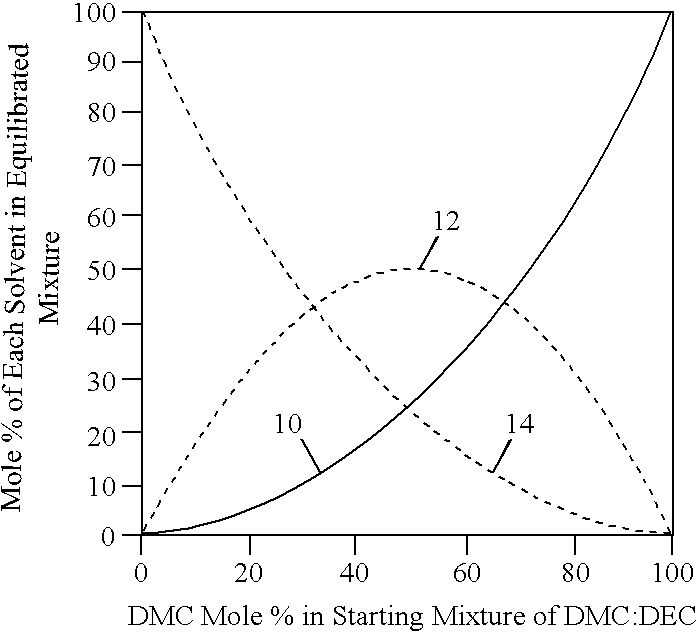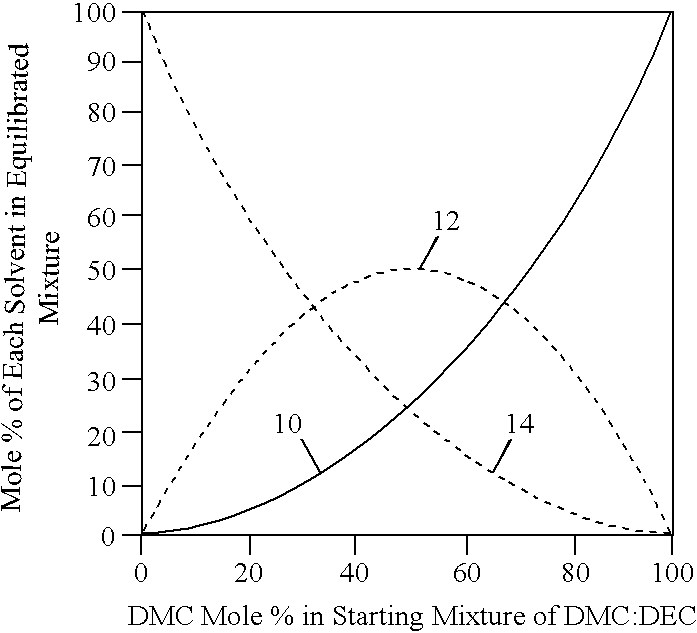Nonaqueous organic electrolytes for low temperature discharge of rechargeable eletrochemical cells
- Summary
- Abstract
- Description
- Claims
- Application Information
AI Technical Summary
Benefits of technology
Problems solved by technology
Method used
Image
Examples
example ii
Electrolyte Preparation and Their Properties
[0053] Eight new electrolytes were prepared by mixing EC with Mixture 1 or Mixture 2 in the molar ratio of 2:8, 3:7, 4:6, and 5:5. A conventional electrolyte was also prepared for comparison, as summarized in Table 4.
4TABLE 4 [LiAsF.sub.6] [LiPF.sub.6] Solvent Vol. Ratio Electrolyte M M EC:DMC:EMC:DEC 1 1.0 20:32:36:12 2 1.0 30:28:32:10 3 1.0 40:24:27:9 4 1.0 50:20:23:7 5 1.0 20:16:40:24 6 1.0 30:14:35:21 7 1.0 40:12:30:18 8 1.0 50:10:25:15 9 1.0 30:70
[0054] The conductivity of these electrolytes was recorded at temperatures ranging from -20.degree. C. to 50.degree. C. with a YSI Model 32 Conductivity Meter. The results are summarized in Table 5.
5TABLE 5 Electrolyte Conductivity (mS) -20.degree. -10.degree. 0.degree. 10.degree. 20.degree. 30.degree. 40.degree. 50.degree. Elec. C. C. C. C. C. C. C. C. 1 3.04 4.22 5.59 6.95 8.59 10.01 11.80 13.35 2 2.71 4.13 5.64 7.06 8.91 10.72 12.38 14.07 3 2.71 3.93 5.40 7.20 8.96 10.87 12.80 14.76 4 2.32...
example iii
Lithium Ion Cell Preparation and Electrochemical Testing
[0058] 1. Cell Preparation
[0059] The cathode was prepared by casting a LiCoO.sub.2 cathode mixture on aluminum foil. The cathode mix contained 91% LiCoO.sub.2, 6% graphite additive and 3% PVDF binder. The anode was prepared similarly by casting an anode mixture containing 91.7% graphite and 8.3% PVDF binder on a copper foil. An electrode assembly was obtained by placing one layer of polyethylene separator between the cathode and the anode and the assembly was spirally wounded into a jellyroll configuration and housed inside of an AA sized cylindrical stainless steel casing. Various groups of AA cells were obtained by activating the electrode assemblies with six different electrolytes, as shown in Table 7.
7TABLE 7 Group Electrolyte (#) # of cells 1 1.0 M LiPF.sub.6 / EC:DMC = 30:70 (#9) 5 2 1.0 M LiASF.sub.6 / EC:DMC = 30:70 5 3 1.0 M LiAsF.sub.6 / EC:DMC:EMC:DEC = 5 20:16:40:24 (#5) 4 1.0 M LiAsF.sub.6 / EC:DMC:EMC:DEC = 4 30:14:35:21 ...
example iv
Charge / Discharge Cycling at Low Temperatures
[0073] After low temperature discharge rate capability tests, the cells constructed in Example III were cycle tested at 0.degree. C. and -20.degree. C. under a discharge rate of 0.14C. Since the groups 1 and 2 prior art cells are known to be incapable of discharging at -20.degree. C., they were only tested at room temperature and at 0.degree. C. All other groups of cells were tested at room temperature, 0.degree. C and -20.degree. C.
[0074] The groups 1 and 2 prior art cells were first cycled three times at room temperature. Then, they were equilibrated at 0.degree. C. for 24 hours before cycling for another three times. Finally, they were cycled three more times at room temperature. For the groups 3 to 6 present invention cells, similar procedures were used except that before the 0.degree. C. test, the cells were tested at -20.degree. C.
[0075] Assuming a room temperature first discharge cycle capacity as a 100% standard, the efficiencies o...
PUM
| Property | Measurement | Unit |
|---|---|---|
| Fraction | aaaaa | aaaaa |
| Fraction | aaaaa | aaaaa |
| Fraction | aaaaa | aaaaa |
Abstract
Description
Claims
Application Information
 Login to View More
Login to View More - R&D
- Intellectual Property
- Life Sciences
- Materials
- Tech Scout
- Unparalleled Data Quality
- Higher Quality Content
- 60% Fewer Hallucinations
Browse by: Latest US Patents, China's latest patents, Technical Efficacy Thesaurus, Application Domain, Technology Topic, Popular Technical Reports.
© 2025 PatSnap. All rights reserved.Legal|Privacy policy|Modern Slavery Act Transparency Statement|Sitemap|About US| Contact US: help@patsnap.com



